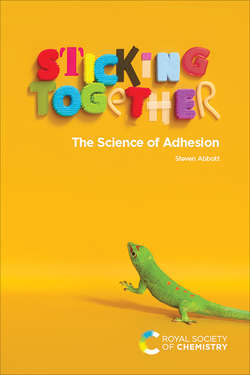Читать книгу Sticking Together - Steven Abbott - Страница 16
На сайте Литреса книга снята с продажи.
2.5 SURFACE TENSION AND ENERGY
ОглавлениеIf you go into your kitchen, take a random assortment of smooth, flat surfaces and place drops of either water, water with a dash of dishwashing liquid, or oil onto the surfaces you will see that the drops form different shapes, depending on both the liquid and the surface.
The liquids have different surface tensions, that is, different forces pulling the liquid together at the surface. Why are there forces pulling the liquid together at the surface? Molecules in the liquid are attracted to each other (if they weren't the liquid would instantly vaporize). At the surface of a drop this self-attraction becomes visible because the way to maximize their self-attraction (or minimize the number of missing attractions at the surface) is to form the smallest-possible surface which is a sphere. Drops containing dishwashing liquid have much weaker attractions at the surface because the surface is covered by a monolayer of the surfactant/detergent with long hydrocarbon tails that interact rather weakly; similarly, the oil has a low surface tension because it is made up mostly of long tails.
The surfaces have different surface energies. This arises for the same reasons – the molecules at the surface want to be with each other to a greater or lesser extent.
If the molecules at the solid surface have a large surface energy (for example a metal surface) compared to the drop then the drop will prefer to spread out on the surface, gaining maximum surface-liquid interaction, rather than curl up on itself in air. On a surface with a low surface energy, such as a Teflon frying pan, the same drop will spread out far less. Oil has a low surface tension and will spread out more on any of your kitchen surfaces than a drop of water, though the difference will depend on the surface itself. The water with the detergent also has a low surface tension so it too will spread out easily on many surfaces – one of the reasons we add detergents.
If you were to look carefully at each drop you would find that it makes a specific angle, called the contact angle, which is diagnostic of the relative surface tensions and surface energies (Figure 2.8).
Figure 2.8 A drop of liquid forms a shape that depends on a combination of the surface tension and surface energy. The result is that the liquid meets the surface at a contact angle, θ.
If you have a Teflon frying pan, then this is “hydrophobic” (water hating) so a water drop does not spread. Even oil is unimpressed by Teflon's surface energy and oil drops hardly spread. With some tricks it is possible to make a “superhydrophobic” surface where a water drop is so unimpressed by the surface that it will roll along at the slightest tilt. These superhydrophobic surfaces have attracted a lot of excitement as self-cleaning surfaces but, although they are marvellous as lab demos, they are generally unsuited to the real world.
It is a common myth that surface energy is important for adhesion. As we will learn in Chapter 3, it is irrelevant for any sort of strong adhesive bond and is used only for those cases where easy breaking of the bond is a requirement – such as when a gecko needs to walk, or you need some temporary adhesion for wrapping a sandwich in a thin plastic film.
